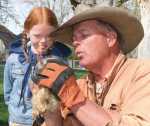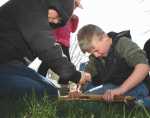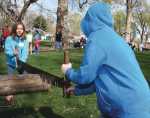Local students saddle up for frontier adventure

Becka Mortensen stood transfixed as Cal Clevenger worked to build a campfire.
A student from West Elementary School, the youngster watched as the trail boss struck a piece of flint with a rounded piece of steel, which caused a few feeble sparks to fly into a piece of dry kindling. With the tinder starting to burn, Clevenger gently breathed on the dying embers to keep them from being extinguished.
The telltale signs of black smoke were quickly followed by a sudden rush of flame, which caught the fourth grader a bit off guard. That small fire was all it took to ignite a larger pile of wood set inside the campfire pit.

With the demonstration complete, Mortensen and the rest of the students gathered around the campfire belted out a hearty "yee ha." It would be the same phrase these children would repeat many times that day as they got to experience what life was really like on the frontier.
Clevenger's fire-making presentation was just one in a series of hands-on lessons taught during this year's Wagons Ho experience. For more than two decades the pioneer camp has brought the flavor of early American life to fourth-grade students from local area schools in practically their own back yard.
Set up at Carl Miller Park, the camp included everything from a covered wagon to a campfire, all of which was aimed at helping students learn how life really was for those living on the American frontier. To a point, it illustrated how tough life got during the four months it took for pioneers traveling on the Oregon Trail to make the trek across the western United States.

"We enjoy that we can make a museum come to life" where children can experience firsthand what life was like for America's pioneers, said Cal Clevenger, who runs the yearly program with his wife, Marla. It's a definite change from walking through a museum where everything's behind glass, he added.
The hands-on teaching environment makes it not only memorable, but it allows these youngsters to better appreciate how tough life could get for those living in the days before technology, Marla Clevenger said.
"We thought kids would really enjoy learning about Idaho history through a hands-on experience," she added.
"I thought it was actually fun because we got to learn about the Old West by experiencing it versus reading about it in a book," said Allie Reid, who attended the camp on Friday with her classmates from North Elementary School.
Her father, Brian Reid, was one of several parents making a return trip to Wagon's Ho. Last year, Reid and his son got a chance to attend the camp.
"We had so much fun (last year) and it was so memorable for him that I wasn't going to pass this up," Reid said. "There's nothing quite like this. It's so hands-on... and they get to use tools they don't normally get to use."
"It's a great experience. It helps give them a perspective on how it was back then," said Juan Palencia, whose younger sister was one of the students from North Elementary School that attended the camp on Friday.
Throughout the day, the students and their adult chaperones visited different stations set up around the park, each one capturing a different aspect of pioneer living.
While the camp was intended to be a fun experience, safety remained the most important lesson taught during each of the three days. Before allowing these young "wranglers" to use anything at the camp, Clevenger took the students and parents to each station and showed them how everything worked. He stressed the need for people to play it safe to avoid injuries.
With children expected to use matches, hammers and sharpened tools, the camp emphasized this message throughout the day with parent chaperones keeping a close eye on their respective group of youngsters.
Wagons Ho was a perfect way for students like Ethan Brown and James Kirby to appreciate the everyday challenges associated with everyday life more than a century ago. Armed with a curved piece of wood, a section of twine and two pieces of wood, the Base Primary School students struggled to create enough friction using just those materials to start a fire.
The experience proved it was a lot harder than they expected.
While most activities were designed for individuals, others like the bandsaw exhibit focused heavily on teamwork. To cut through a section of a roughly nine-inch-thick log, children like Addy Rendon and Cyrus Carlesness from the Base Primary School needed to work in unison to successfully and quickly cut through this stubborn piece of lumber.
The tenacity of the students to slice through the log earned them privilege of holding onto the cut timber as a keepsake for their class.
Teamwork was heavily stressed during each camp. If pioneers didn't work together, there was little chance they would ever survive on the frontier, Clevenger said.
For some students, it allowed them to appreciate the comforts of home that were not around during the pioneer days. Jose Diaz from West Elementary School discovered, for example, that washing clothes with only a washboard and cold, soapy water was not nearly as fun as it looked.
"I had kids saying how they really like having a washing machine at home," Diana Palencia said. The alternative of washing everything by hand didn't sit very well with a number of the students.
Clevenger emphasized that everything these students did that day were not chores. They were simply jobs that needed to be done if people were to survive on the frontier.
But not every activity required a strong arm to complete. Emily Duncan from the Base Primary School used a hand drill to punch a pair of holes in a thin, rounded piece of wood. She then spent several minutes polishing the rough surfaces using nothing more than a smooth rock to turn that piece of timber into a clothing button.
When they had a break during the day's lessons, students like Asia Horenziak and Jenna Oppenedyk spend their time putting the final touches on those buttons. Like many of her fellow students from North Elementary, Horenziak continued to work on the button, "because I wanted it really shiny," she said.
Despite the lure of chopping wood or learning to create a fire, the roping exhibit remained a popular destination for many students. During their allotted time, Kaitlyn Kennedy and her classmates from the Base Primary School tried their best to swing a lasso around their heads and throw it accurately enough to snag the revolving steel frame that represented a runaway calf.
For most of the aspiring cowboys and cowgirls that swung a lasso, their attempts tended to fall way short.
Following the morning's hands-on lessons, the day's festivities focused on fun and friendly competition. The youngsters had a chance to participate in a series of games, including an egg race -- using raw eggs that sometimes didn't survive to the finish line.
Afterward, the students participated in potato sack races before they wrapped up with a series of tug-of-war matches. Each team dug in their spurs, so to speak, to earn bragging rights for the rest of the afternoon.
Most students had their own favorite moments during Wagon's Ho. Others like Spencer Gallup from North Elementary had several personal favorites.
"Sawing wood was awesome and making mountain man buttons was also awesome," Gallup said. "And learning how to lasso was also fun."
But having a second helping of freshly cooked beef stew was his favorite part of the day.
"It was tasty," said Gallup as he held an empty lunch plate.
Throughout the day, the children were asked to put the experiences to paper and pencil. Some took time to either write a thank you note, jot down their thoughts or just draw something that interested them during their day as pioneers. River Tapley from North Elementary drew a picture of what he'd already done so far that day and what he still needed to do that afternoon.
The Clevengers reassured the students they would read every message these children wrote.
